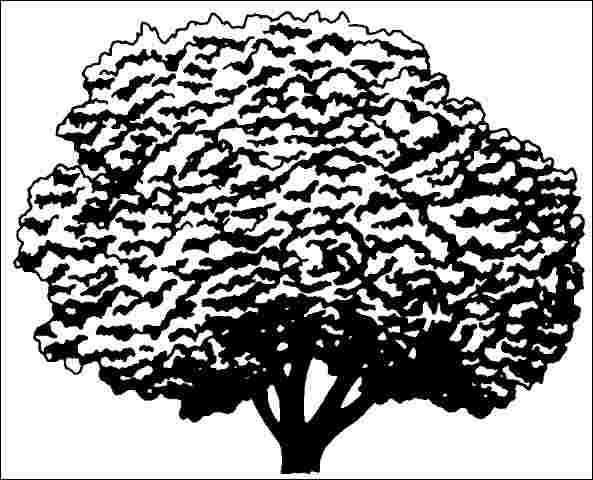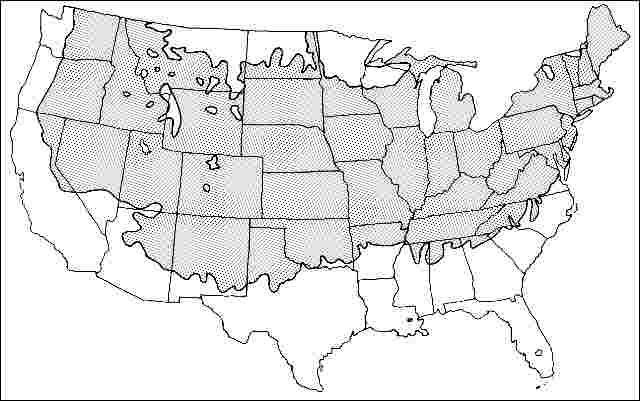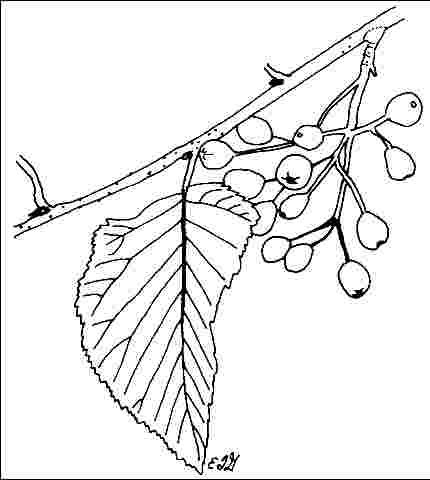Introduction
Korean mountain ash grows rather quickly into a 20- to 40-foot-tall deciduous tree with a broad, rounded, 15- to 25-foot-wide, dense canopy which casts dense shade below. Young trees form a dense oval. The two to four-inch-long, glossy, bright green, simple leaves change to attractive hues of yellow, orange, and rust in fall before dropping. In late spring the trees are decorated with two to three-inch-diameter, flat-topped clusters of tiny white blossoms, which may appear in great number one year yet sparsely the next. These blooms are followed by the production of small but very showy, red to yellow fruits which pendulously hang in five-inch clusters of two to ten berries from tree branches. Fruit clusters are not as dense as those of Sorbus aucuparia. The smooth, grey bark of the branches provides a nice contrast for these colorful fruits. These attractive, abundant fruits ripen and cling to the tree, providing a welcome feast for various types of weary, migrating birds. Fruit are displayed nicely after leaves fall in autumn.

General Information
Scientific name: Sorbus alnifolia
Pronunciation: SOR-bus al-nih-FOLE-ee-uh
Common name(s): Korean mountain ash
Family: Rosaceae
USDA hardiness zones: 4A through 7A (Fig. 2)
Origin: not native to North America
Invasive potential: little invasive potential
Uses: tree lawn 3-4 feet wide; tree lawn 4-6 feet wide; tree lawn > 6 ft wide; reclamation; specimen; street without sidewalk; parking lot island 100-200 sq ft; parking lot island > 200 sq ft
Availability: somewhat available, may have to go out of the region to find the tree

Description
Height: 20 to 40 feet
Spread: 15 to 25 feet
Crown uniformity: symmetrical
Crown shape: oval, vase
Crown density: dense
Growth rate: fast
Texture: medium
Foliage
Leaf arrangement: alternate (Fig. 3)
Leaf type: simple
Leaf margin: serrate, double serrate
Leaf shape: elliptic (oval), ovate
Leaf venation: pinnate
Leaf type and persistence: deciduous
Leaf blade length: 2 to 4 inches
Leaf color: green
Fall color: yellow, red, copper, orange
Fall characteristic: showy

Flower
Flower color: white/cream/gray
Flower characteristics: showy
Fruit
Fruit shape: round
Fruit length: less than .5 inch, .5 to 1 inch
Fruit covering: fleshy
Fruit color: red
Fruit characteristics: attracts birds; showy; fruit/leaves not a litter problem
Trunk and Branches
Trunk/bark/branches: branches don't droop; not showy; typically multi-trunked; thorns
Pruning requirement: little required
Breakage: susceptible to breakage
Current year twig color: brown
Current year twig thickness: medium
Wood specific gravity: unknown
Culture
Light requirement: full sun
Soil tolerances: clay; sand; loam; slightly alkaline; acidic; well-drained
Drought tolerance: moderate
Aerosol salt tolerance: moderate
Other
Roots: not a problem
Winter interest: no
Outstanding tree: yes
Ozone sensitivity: unknown
Verticillium wilt susceptibility: unknown
Pest resistance: resistant to pests/diseases
Use and Management
Partially due to the upright habit, weak crotches can develop on branches which are allowed to grow to larger than about half the diameter of the trunk. Pruning early in the life of the tree will improve the structure of the tree and help increase longevity in the landscape.
It is tempting to plant this tree due to the nice flowers, nice fruit display and bright fall color, but it may be short-lived and is susceptible to fireblight. But it is the most resistant of the mountain ashes to borers. It is probably best to locate the tree where there is adequate open soil space for root development so the tree will not be subjected to much stress. Provided with some irrigation in a dry summer, this tree will serve the landscape well for a number of years. It has many outstanding attributes which people will enjoy for a number of years after planting. Plant it as an occasional specimen in a park or large landscape for ornamental value and diversity, not as a staple in large numbers.
Korean mountain ash should be grown in full sun on any well-drained soil, including slightly alkaline. Any required pruning should be done in winter or early spring to avoid exposing the wood to the fireblight disease. Fireblight can cause serious damage to the tree.
The cultivar 'Redbird' has rosy red fruits which are quite popular with birds, and has a more upright form. There are other hybrids and cultivars, all with the same limitations.
Propagation is by seed, with difficulty, or by grafting.
Pests
Aphids, pear leaf blister mite, Japanese leafhopper, mountain ash sawfly, and scales may infest this tree. Korean mountain ash is somewhat resistant to borers which affect other Sorbus species, and probably should be planted instead of European mountain ash.
Diseases
Fireblight, crown gall, canker, leaf rusts, and scab may infect this tree.